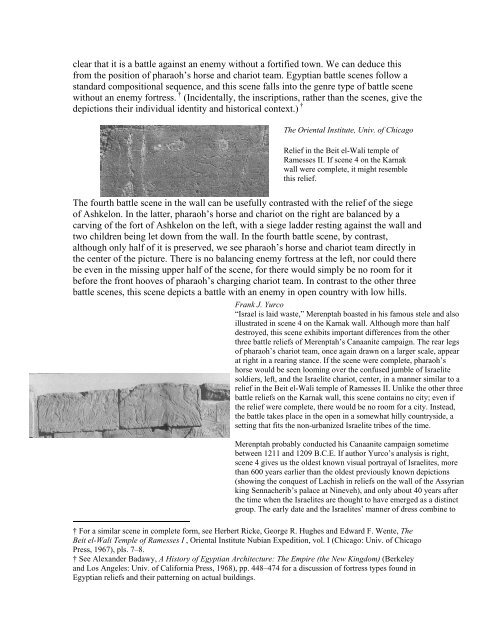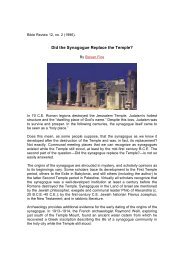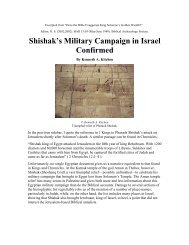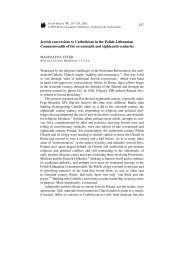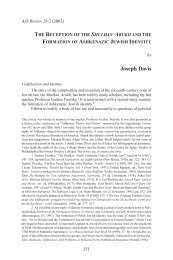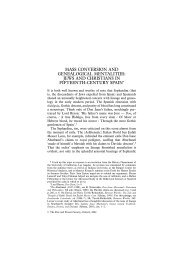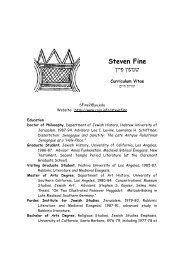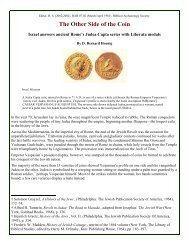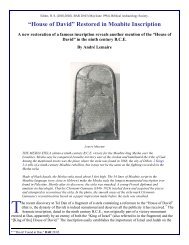3200-Year-Old Picture of Israelites Found in Egypt
3200-Year-Old Picture of Israelites Found in Egypt
3200-Year-Old Picture of Israelites Found in Egypt
Create successful ePaper yourself
Turn your PDF publications into a flip-book with our unique Google optimized e-Paper software.
clear that it is a battle aga<strong>in</strong>st an enemy without a fortified town. We can deduce this<br />
from the position <strong>of</strong> pharaoh’s horse and chariot team. <strong>Egypt</strong>ian battle scenes follow a<br />
standard compositional sequence, and this scene falls <strong>in</strong>to the genre type <strong>of</strong> battle scene<br />
without an enemy fortress. † (Incidentally, the <strong>in</strong>scriptions, rather than the scenes, give the<br />
depictions their <strong>in</strong>dividual identity and historical context.) †<br />
The Oriental Institute, Univ. <strong>of</strong> Chicago<br />
Relief <strong>in</strong> the Beit el-Wali temple <strong>of</strong><br />
Ramesses II. If scene 4 on the Karnak<br />
wall were complete, it might resemble<br />
this relief.<br />
The fourth battle scene <strong>in</strong> the wall can be usefully contrasted with the relief <strong>of</strong> the siege<br />
<strong>of</strong> Ashkelon. In the latter, pharaoh’s horse and chariot on the right are balanced by a<br />
carv<strong>in</strong>g <strong>of</strong> the fort <strong>of</strong> Ashkelon on the left, with a siege ladder rest<strong>in</strong>g aga<strong>in</strong>st the wall and<br />
two children be<strong>in</strong>g let down from the wall. In the fourth battle scene, by contrast,<br />
although only half <strong>of</strong> it is preserved, we see pharaoh’s horse and chariot team directly <strong>in</strong><br />
the center <strong>of</strong> the picture. There is no balanc<strong>in</strong>g enemy fortress at the left, nor could there<br />
be even <strong>in</strong> the miss<strong>in</strong>g upper half <strong>of</strong> the scene, for there would simply be no room for it<br />
before the front hooves <strong>of</strong> pharaoh’s charg<strong>in</strong>g chariot team. In contrast to the other three<br />
battle scenes, this scene depicts a battle with an enemy <strong>in</strong> open country with low hills.<br />
Frank J. Yurco<br />
“Israel is laid waste,” Merenptah boasted <strong>in</strong> his famous stele and also<br />
illustrated <strong>in</strong> scene 4 on the Karnak wall. Although more than half<br />
destroyed, this scene exhibits important differences from the other<br />
three battle reliefs <strong>of</strong> Merenptah’s Canaanite campaign. The rear legs<br />
<strong>of</strong> pharaoh’s chariot team, once aga<strong>in</strong> drawn on a larger scale, appear<br />
at right <strong>in</strong> a rear<strong>in</strong>g stance. If the scene were complete, pharaoh’s<br />
horse would be seen loom<strong>in</strong>g over the confused jumble <strong>of</strong> Israelite<br />
soldiers, left, and the Israelite chariot, center, <strong>in</strong> a manner similar to a<br />
relief <strong>in</strong> the Beit el-Wali temple <strong>of</strong> Ramesses II. Unlike the other three<br />
battle reliefs on the Karnak wall, this scene conta<strong>in</strong>s no city; even if<br />
the relief were complete, there would be no room for a city. Instead,<br />
the battle takes place <strong>in</strong> the open <strong>in</strong> a somewhat hilly countryside, a<br />
sett<strong>in</strong>g that fits the non-urbanized Israelite tribes <strong>of</strong> the time.<br />
Merenptah probably conducted his Canaanite campaign sometime<br />
between 1211 and 1209 B.C.E. If author Yurco’s analysis is right,<br />
scene 4 gives us the oldest known visual portrayal <strong>of</strong> <strong>Israelites</strong>, more<br />
than 600 years earlier than the oldest previously known depictions<br />
(show<strong>in</strong>g the conquest <strong>of</strong> Lachish <strong>in</strong> reliefs on the wall <strong>of</strong> the Assyrian<br />
k<strong>in</strong>g Sennacherib’s palace at N<strong>in</strong>eveh), and only about 40 years after<br />
the time when the <strong>Israelites</strong> are thought to have emerged as a dist<strong>in</strong>ct<br />
group. The early date and the <strong>Israelites</strong>’ manner <strong>of</strong> dress comb<strong>in</strong>e to<br />
† For a similar scene <strong>in</strong> complete form, see Herbert Ricke, George R. Hughes and Edward F. Wente, The<br />
Beit el-Wali Temple <strong>of</strong> Ramesses I , Oriental Institute Nubian Expedition, vol. I (Chicago: Univ. <strong>of</strong> Chicago<br />
Press, 1967), pls. 7–8.<br />
† See Alexander Badawy, A History <strong>of</strong> <strong>Egypt</strong>ian Architecture: The Empire (the New K<strong>in</strong>gdom) (Berkeley<br />
and Los Angeles: Univ. <strong>of</strong> California Press, 1968), pp. 448–474 for a discussion <strong>of</strong> fortress types found <strong>in</strong><br />
<strong>Egypt</strong>ian reliefs and their pattern<strong>in</strong>g on actual build<strong>in</strong>gs.


